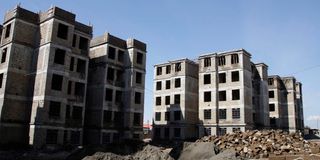Premium
What Kenya can learn from West on affordable housing

Affordable Housing Project in Elburgon, Nakuru County on July 12, 2024. The project which has 220 units is expected to be completed by September this year.
Government efforts to promote affordable housing in the United States, United Kingdom and Canada have been complicated by speculation and runaway real estate prices in recent years, putting the provision of cheaper homes in jeopardy.
Unlike in Kenya, where affordable housing policies may target the country’s poorest, many developed nations face a pronounced housing crisis that affects even the middle class, and has become a defining issue in national elections. While government policies have increasingly focused on market interventions, tension between housing being a highly profitable investment and a necessity of life has seen real estate prices boom, keeping housing out of reach for many.
When it comes to society’s poorest—homeless or unhoused people—the US, UK, Canada, and peer countries typically use patchwork programmes. These efforts, long criticised over their ineffectiveness, are typically a combination of social programmes that attempt to address root causes of homelessness in addition to providing short-term housing.
Wealthy countries engaged in a flurry of public housing development through the 1960s and 1970s, funded directly by the government and targeted at families that would rent units.
In 1980, UK Prime Minister Margaret Thatcher allowed public housing tenants to buy the units they rented, which has contributed to reduced cheap housing supply in Britain. Some legacy publicly-built housing continues to be available to low-income families, though supply has stagnated amid rising demand.
Moreover, since much of the housing stock is now more than 50 years old, safety and suitability of living conditions is an increasing worry, and most Western governments have since turned to the private sector to build.
Today, many government programmes to promote affordable housing focus on market interventions on both the supply and demand side. This may include providing low-interest loans to developers who promise to keep rents lower for a set number of units, or giving first-time buyers low-interest loans for a set percentage of a property’s equity.
Some interventions do see payments to low-income families. In New York City, a two-person household with a combined income of less than $62,150 (Sh7.96 million) is eligible for rental subsidies. A key barrier to affordability, however, remains the limited supply of housing and government funding against rising demand. New York reopened its rental subsidy programme in June after almost 15 years and had hundreds of thousands of applicants.
Rising real estate prices and housing market speculation in the era of low interest rates following the 2008-2009 financial crisis has exacerbated issues of access to affordable housing. One market that exemplifies these challenges is Toronto, Canada, where a study found that home prices rose more than 40 per cent between 2019 and 2024, a trend that some analysts linked to the proliferation of real estate investment.
While the US, UK and Canada have a long history of affordable housing policies, all three continue to face structural issues with the actual provision of housing—and it became a leading issue in the latest UK election. These three countries have the highest share of low-income private tenants that spend more than 40 per cent of their income on rent among the Organisation for Economic Co-operation and Development, a group of 38 countries.
Market forces, including speculative investment, have become a key barrier to sustainable housing policies, in what could be a warning for Kenya’s foray into affordable housing policy.
Kenyan house price growth has lagged developed countries, but is on the rise amid continued urbanisation—a trend that may eventually complicate efforts to make housing more accessible.





